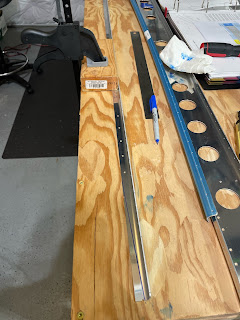Now that we have finally completed the rudder, we are onto the next section. This section, the Horizontal Stabilizer is much bigger than past sections we have worked on. I had to run down to my storage unit to pickup the pieces, and I ended up having to get creative. If you plan to put your parts into storage like me, I recommend trying to keep the longer parts at home, it's just easier than getting back and forth. Smaller things like tail cone parts, skins, and other pieces are easier to transport.
 |
| The HS Spars are a bit long.... |
Despite the creative method to get parts home, I was ready to go and didn't wait long. We reorganized my workbenches into a lengthwise arrangement and got to work cleaning up a bit. It's amazing how much dust, debris, and other crap gets stuck under the tables when they aren't moved for a while. It was nice cleaning up the garage before moving on. The first page had me getting the doubler setup and the spar match drilled. It was extremely straightforward and didn't require any heavy lifting.
 |
| Match drilling the Horizontal Spar |
After doing this, it wanted me to disassemble, prime and rivet. It is a tiny batch of parts and I didn't want to bust out my priming setup for nothing. The next page had me cutting down the spar caps, stringers, and the doubler for the other spar. I decided to move onto this section and prep all of these parts. This would give me a larger batch of parts to prime at once. The parts weren't hard to cut down, it was similar to the same thing I did on the Vertical Stabilizer spar.
I also got to do my first bearing of the project. This was pretty straightforward and explained well. It had me cleco the sections together and then rivet everything together. It required me to clamp the parts down to avoid any warping. The flange parts are all done and ready to get mounted after priming.
 |
| Completed Flange Bearing |
Next week I will complete deburring the stringers and spar caps. Then we will be ready to prime everything together and get to riveting. This part should move quickly and once I have the priming done, we will get to assembling everything. Also on my list of things to do is a trip to Lowe's. I need to pick up some wood to make the stands for assembling the Horizontal Stabilizer.
 |
| The "Before" Picture.... The End to come in a few updates. |











